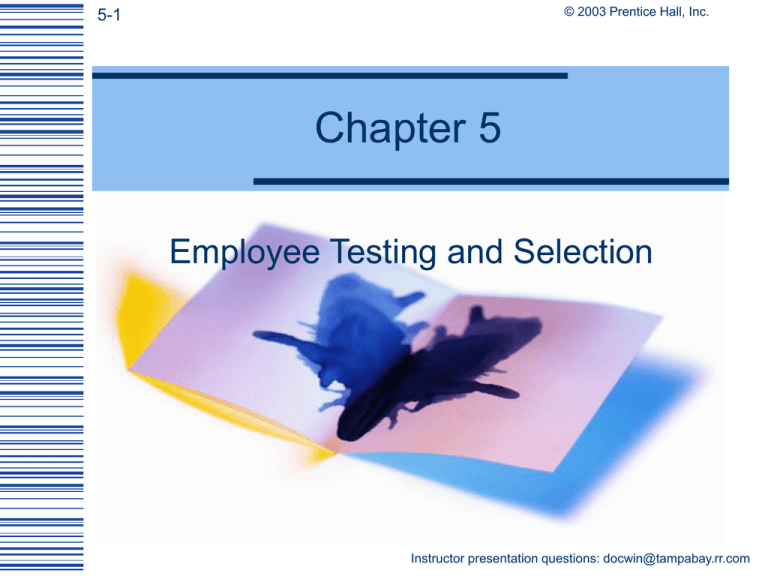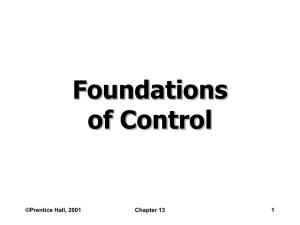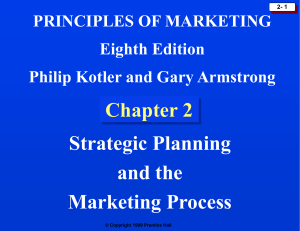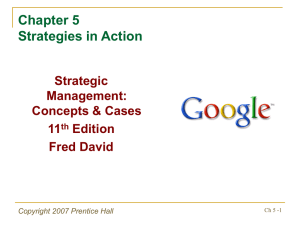April 29 Ch 5
advertisement

© 2003 Prentice Hall, Inc. 5-1 Chapter 5 Employee Testing and Selection Instructor presentation questions: docwin@tampabay.rr.com 5-2 © 2003 Prentice Hall, Inc. What You Should Be Able to Do (Cont.) Describe the overall selection process List the ethical and legal issues in testing Explain how you would go about validating a test List eight tests you could use for employee selection, and how you would use them 5-3 © 2003 Prentice Hall, Inc. What You Should Be Able to Do (Cont.) Cite and illustrate our testing guidelines Explain what an assessment center is Explain the key points to remember in conducting background investigations 5-4 © 2003 Prentice Hall, Inc. Employee Testing and Selection Employee testing and selection is the use of various tools and techniques to select the best candidates for the job. These tools cover the selection process, basic testing techniques, background and reference checks, ethical and legal questions in testing, types of tests, and work samples and simulations. 5-5 © 2003 Prentice Hall, Inc. Why Careful Selection Is Important HR manager’s performance depends on the performance of subordinates The cost to recruit and hire is high Legal implications of incompetent hiring are costly and can result in negligent hiring litigation 5-6 © 2003 Prentice Hall, Inc. How to Avoid Litigation Carefully scrutinize Get written okay Save records Reject applicants Balance privacy rights with ‘need to know’ Take immediate action © 2003 Prentice Hall, Inc. 5-7 Testing Concepts 101 Test validity checks whether or not a test measures what it is supposed to measure Criterion Both test validity Content Test reliability = a test’s consistency or accuracy Validity and reliability aid in effective applicant selection © 2003 Prentice Hall, Inc. 5-8 Test Validity A typing test corresponds to an on-thejob behavior Thematic apperception test asks a person to interpret a picture (like that shown below) © 2003 Prentice Hall, Inc. 5-9 Test Reliability Does the same test given to the same person result in the same test outcome? Retest estimate Equivalent form estimate e.g. SAT Internal consistency or comparison estimate 5-10 © 2003 Prentice Hall, Inc. Causes of Test Unreliability Questions may do poor job of sampling the material Changes in testing condition may cause errors More causes listed in the internet appendix © 2003 Prentice Hall, Inc. 5-11 How to Validate a Test 1 Analyze job & write description 2 Choose the tests Administer 3 tests 4 Relate scores & criteria 5 Cross-validate & revalidate 5-12 © 2003 Prentice Hall, Inc. 1 Analyze Job & Write Job Description Determine and specify predictors or requirements necessary for successful performance Define what you mean by success on the job Write the job description and job specification 5-13 © 2003 Prentice Hall, Inc. 2 Choose the Tests Choose tests that measure attributes needed for success and combine into a test battery that measures an array of possible predictors such as aggressiveness, extroversion and numerical ability © 2003 Prentice Hall, Inc. 5-14 Choose the Tests Available tests include: Psychological Intellectual Technical Aptitude Interest inventories Reliability inventories Visit Applied Assessments Clerical skills test Telemarketing ability tests Service ability tests Management aptitude test Team skills test Sales ability test © 2003 Prentice Hall, Inc. 5-15 3 Give the Tests Two formats Concurrent validation Predictive validation Give tests to employees Compare scores with current performance Test applicant before hiring Use alternate selection technique to hire Compare real performance with test results – determines suitability of test © 2003 Prentice Hall, Inc. 5-16 4 Relate Test Scores and Criteria Does a statistical relationship exist between the test scores and job performance? Test Scores Top 20% Next 20% Middle 20% Next 20% Expectancy Chart Bottom 20% 0 50 100 Percent chances to be a "High Performer" © 2003 Prentice Hall, Inc. 5-17 High job performance Low job performance Low Test Score High Test Score High Positive Correlation of Selection Test Scores and Performance on Job © 2003 Prentice Hall, Inc. 5-18 High job performance Low job performance Low Test Score High Test Score Low Positive Correlation of Selection Test Scores and Performance on Job © 2003 Prentice Hall, Inc. 5-19 High job performance Low job performance Low Test Score High Test Score High Negative Correlation of Selection Test Scores and Performance on Job © 2003 Prentice Hall, Inc. 5-20 5 Cross-validate and Revalidate To cross-validate, perform Steps 3 and 4 on a new sample of employees An expert should revalidate the test periodically To demonstrate content validity: Do a careful job analysis that identifies the work behavior required Combine samples of these behaviors into a test © 2003 Prentice Hall, Inc. 5-21 Has 5 or more years of experience Holds MBA or more High Interview Test Score of Scores 90 or More © 2003 Prentice Hall, Inc. 5-22 Multiple Cutoff Procedure High Performance B A C A C C B B A Predictor 1 Predictor 2 Predictor 3 Weighted Composite Procedure C B A Predictor 1 + 2 + 3 © 2003 Prentice Hall, Inc. 5-23 EEO Aspect of Testing Validity tests must meet Equal Employment Opportunity Laws in two key ways Your tests are related to success or failure on the job (validity) Your tests don’t unfairly discriminate against minority or non-minority subgroups 5-24 © 2003 Prentice Hall, Inc. Guidelines for a Testing Program Use tests as supplements Validate tests with your own organization Analyze all your current hiring and promotion standards Keep accurate records Use a certified psychologist Manage test conditions 5-25 © 2003 Prentice Hall, Inc. Test Takers Individual Rights Confidentiality Informed consent Expect that only qualified people will interpret and have access to test results Expect the test is fair to all – no one has answers in advance © 2003 Prentice Hall, Inc. 5-26 Perceived Fairness to Test Takers Follow good test practices – a quiet, monitored test room The “obviousness” of the line between the selection procedure and the job Graphology Unfair Honesty & Personality Neutral Written Ability Biographical Interviews & Information Work Sample Favorable Fair 5-27 © 2003 Prentice Hall, Inc. Privacy and the Law Supreme court decisions protect us from intrusive government action by setting limits on disclosure of personal information Common law of torts precludes disclosure of personal information outside the company Some states recognize common law as it applies to invasion of privacy © 2003 Prentice Hall, Inc. 5-28 Guidelines for Privacy Train your supervisors regarding the importance of employee confidentiality Adopt a “need to know” policy If you know your firm can’t keep information confidential, you may limit your liability by disclosing that fact before testing © 2003 Prentice Hall, Inc. 5-29 Using Tests at Work Are you prone to accidents at work? This test helps you rate your chances 5-30 © 2003 Prentice Hall, Inc. Computerized Testing Visit Their tests reduce costs and raise quality © 2003 Prentice Hall, Inc. 5-31 Types of Tests Cognitive Which shape has the greatest area? Intelligence quotient Specific cognitive abilities or aptitude Motor and physical ability Dexterity Smoothest ride? A, B, or C? © 2003 Prentice Hall, Inc. 5-32 Types of Tests Personality and interests Interest inventories Achievement What is ‘tolerance’? © 2003 Prentice Hall, Inc. 5-33 Types of Tests Wonderlic personal characteristics inventory measures general mental ability Predictive Index measures work-related personality traits, drives, and behaviors Projective techniques like MAPS, HTP, and Forer Structured Sentence Completion © 2003 Prentice Hall, Inc. 5-34 Even More About Tests! Effectiveness The “Big Five” Interest Inventories Achievement Tests 5-35 © 2003 Prentice Hall, Inc. Smart or Personable Both personality and intelligence drive careers When defining career success in terms of intrinsic and extrinsic success, conscientiousness predicted both Neuroticism negatively predicted extrinsic success Intelligence positively predicted extrinsic career success 5-36 © 2003 Prentice Hall, Inc. Work Sampling for Employee Selection Work samples measure actual on-the-job tasks Work sampling technique measure how one performs some of the job’s basic tasks Benefits include fairness to minorities, accuracy, no invasion of privacy and better predictor of performance 5-37 © 2003 Prentice Hall, Inc. Management Assessment Centers A management assessment center is a two to three-day simulation in which 10 to 12 candidates perform realistic management tasks (like making presentations) under the observation of experts who appraise each candidate’s leadership potential © 2003 Prentice Hall, Inc. 5-38 Typical MAC Exercises The In-basket Leaderless group discussion Management games Individual presentations Objective tests The interview © 2003 Prentice Hall, Inc. 5-39 Video Based Situational Tests Presents candidate with several scenarios Well, I’m glad you’re here. Oh? Why is that? Look at this place, that’s why! I take a day off and come back to find this mess. But I didn’t work late last night. Maybe not but this has happened before. © 2003 Prentice Hall, Inc. 5-40 Video Based Situational Tests If you were this associate what would you do? a. Let the other associates responsible for the mess know that you had to take the heat. b. Straighten up the department, and try to reason with the manager later. c. Suggest to the manager that he talk to the other associates who made the mess. d. Take it up with the manager’s boss. e. Quit! 5-41 © 2003 Prentice Hall, Inc. Other Selection Techniques Background investigations are effective because they verify factual information and may uncover criminal records Reference checking is harder as several federal laws give rejected applicant rights to know the information which might result in litigation 5-42 © 2003 Prentice Hall, Inc. Reference Check Form 5-43 © 2003 Prentice Hall, Inc. Reference Check Form (Cont.) © 2003 Prentice Hall, Inc. 5-44 Giving and Getting References Giving references: know the law Common law Defamation Making background checks more useful 5-45 © 2003 Prentice Hall, Inc. Pre-employment Information Services Services store and search databases to delve into candidate criminal, driving, work, and credit histories Various EEO laws discourage or prohibit their use in candidate screening Non-EEO laws restrict their use 5-46 © 2003 Prentice Hall, Inc. Guidelines for Using Background Information Checks Check all applicable state laws Review the impact of federal equal employment laws Remember the Federal Fair Credit Reporting Act Do not obtain information that you’re not going to use 5-47 © 2003 Prentice Hall, Inc. Guidelines for Using Background Information Checks Remember that using arrest information will be highly suspect Avoid blanket policies Use information that is specific and job related Keep information confidential and up to date Never authorize an unreasonable investigation © 2003 Prentice Hall, Inc. 5-48 Honesty Testing The polygraph can no longer be used routinely Paper and pencil honesty tests are widely used to find personality flaws Research shows that honesty testing can spot problems 5-49 © 2003 Prentice Hall, Inc. What’s an Employer to Do? Ask blunt questions Be good listeners Do a credit check Check all personal and employment references Use paper & pencil honesty as well as psych tests Test for drugs Establish a search and seizure policy 5-50 © 2003 Prentice Hall, Inc. Hand Writing Tests Graphology may not be used as a screening test as it is not reliable 5-51 © 2003 Prentice Hall, Inc. Physical Exams Once hired, a physical examination is the next step in the selection process Used to verify applicant meets physical demands of the job Establish a baseline for future insurance claims Reduce absenteeism and accidents Must be careful not to violate ADA laws 5-52 © 2003 Prentice Hall, Inc. Substance Abuse Screening Many employers use drug testing although it is not always reliable and can be ‘fooled’ May raise ethical issues May not be legal in some cases as it violates right to privacy A positive test leads to termination or a refusal to hire © 2003 Prentice Hall, Inc. 5-53 High Performance Insight The problem: High turnover Franciscan Health System operates skilled nursing care facilities in Ohio. It faced several problems, including high turnover of 146%/year. Their solution: Cut turnover to 71%/year They devised a nursing assistant test battery consisting of three tests: • An employment inventory • A personality survey • A job preferences inventory 5-54 © 2003 Prentice Hall, Inc. City Garage Strategic HR Rapidly growing city garage needed a better process than an application form and short interview Employee selection was haphazard with some managers being better at hiring than others Selected Thomson International’s Personality Profile Analysis program as a third step in their hiring process 5-55 © 2003 Prentice Hall, Inc. Complying With Immigration Law Hire only citizens & aliens lawfully authorized Advise new job applicants of your policy Complete & sign the verification form I-9 Examine documentation presented by new employees Retain the form Present the form for inspection by INS or DOL officers 5-56 © 2003 Prentice Hall, Inc. Summary of Chapter 5 Testing for screening and job candidate selection Test validity (including criterion and content) Reliability or consistency of tests The many types of personnel tests 5-57 © 2003 Prentice Hall, Inc. Summary of Chapter 5 (Cont.) The 5 steps to make a selection test useful EEO laws regarding tests and some basic test guidelines Work sampling selection techniques Management Assessment Centers And background and reference checks Whew!





